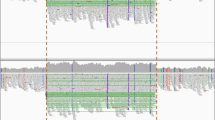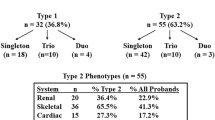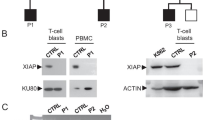Abstract
The hyper-immunoglobulin E syndrome (HIES) is a rare primary immunodeficiency characterized by recurrent infections, elevated serum IgE-levels, and involvement of the soft- and bony tissues. We speculated that this complex disease may be caused by a microdeletion syndrome. We therefore analyzed 30 sporadic HIES patients for the presence of chromosomal imbalances using Affymetrix 50k XbaI and 23 of the 30 patients with the higher-resolution 250k StyI SNP mapping arrays. We detected only eight different copy number alterations in six patients with the 50k approach, and seven of these presented known polymorphic regions not associated with disease. However, one patient showed a unique gain on chromosome 20p. 250k array analysis identified this gain as a rare polymorphism segregating in the patient’s family, but not associated with the HIES phenotype. In addition, 265 known and novel copy number variants (CNVs) were identified with the 250k arrays, but no recurrent imbalances reminescent of a microdeletion syndrome were found. We aligned the identified CNVs with loci that have been associated with HIES or phenotypically overlapping syndromes. Doing so, a 2-Mb deletion spanning the PEPD gene on 19q13.11 was identified on one allele of one patient. Homozygous mutations in PEPD are responsible for the autosomal-recessive prolidase deficiency which resembles HIES in some aspects. Sequencing of the healthy allele, however, revealed a wild-type sequence. In summary, our results suggest that HIES is not likely to be a microdeletion syndrome.

Similar content being viewed by others
References
Bignell GR, Huang J, Greshock J, Watt S, Butler A, West S, Grigorova M, Jones KW, Wei W, Stratton MR, Futreal PA, Weber B, Shapero MH, Wooster R (2004) High-resolution analysis of DNA copy number using oligonucleotide microarrays. Genome Res 14:287–295
International HapMap Consortium (2005) A haplotype map of the human genome. Nature 437:1299–1320
Girirajan S, Vlangos CN, Szomju BB, Edelman E, Trevors CD, Dupuis L, Nezarati M, Bunyan DJ, Elsea SH (2006) Genotype–phenotype correlation in Smith-Magenis syndrome: evidence that multiple genes in 17p11.2 contribute to the clinical spectrum. Genet Med 8:417–427
Grimbacher B, Dutra AS, Holland SM, Fischer RE, Pao M, Gallin JI, Puck JM (1999a) Analphoid marker chromosome in a patient with hyper-IgE syndrome, autism, and mild mental retardation. Genet Med 1:213–218
Grimbacher B Holland SM, Gallin JI, Greenberg F, Hill SC, Malech HL, Miller JA, O’Connell AC, Puck JM (1999b) Hyper-IgE syndrome with recurrent infections–an autosomal dominant multisystem disorder. N Engl J Med 340:692–702
Grimbacher B, Schaffer AA, Holland SM, Davis J, Gallin JI, Malech HL, Atkinson TP, Belohradsky BH, Buckley RH, Cossu F, Espanol T, Garty BZ, Matamoros N, Myers LA, Nelson RP, Ochs HD, Renner ED, Wellinghausen N, Puck JM (1999c) Genetic linkage of hyper-IgE syndrome to chromosome 4. Am J Hum Genet 65:735–744
Grimbacher B, Holland SM, Puck JM (2005) Hyper-IgE syndromes. Immunol Rev 203:244–250
Holland SM, Deleo FR, Elloumi HZ, Hsu AP, Uzel G, Brodsky N, Freeman AF, Demidowich A, Davis J, Turner ML, Anderson VL, Darnell DN, Welch PA, Kuhns DB, Frucht DM, Malech HL, Gallin JI, Kobayashi SD, Whitney AR, Voyich JM, Musser JM, Woellner C, Schaffer AA, Puck JM, Grimbacher B (2007) STAT3 mutations in the hyper-IgE syndrome. N Engl J Med 357:1608–1619
Huang J, Wei W, Zhang J, Liu G, Bignell GR, Stratton MR, Futreal PA, Wooster R, Jones KW, Shapero MH (2004) Whole genome DNA copy number changes identified by high density oligonucleotide arrays. Hum Genomics 1:287–299
Iafrate AJ, Feuk L, Rivera MN, Listewnik ML, Donahoe PK, Qi Y, Scherer SW, Lee C (2004) Detection of large-scale variation in the human genome. Nat Genet 36:949–951
Komura D, Shen F, Ishikawa S, Fitch KR, Chen W, Zhang J, Liu G, Ihara S, Nakamura H, Hurles ME, Lee C, Scherer SW, Jones KW, Shapero MH, Huang J, Aburatani H (2006) Genome-wide detection of human copy number variations using high-density DNA oligonucleotide arrays. Genome Res 16:1575–1584
Meyer-Lindenberg A, Mervis CB, Berman KF (2006) Neural mechanisms in Williams syndrome: a unique window to genetic influences on cognition and behaviour. Nat Rev Neurosci 7:380–393
Minegishi Y, Saito M, Morio T, Watanabe K, Agematsu K, Tsuchiya S, Takada H, Hara T, Kawamura N, Ariga T, Kaneko H, Kondo N, Tsuge I, Yachie A, Sakiyama Y, Iwata T, Bessho FOhishi T, Joh K, Imai K, Kogawa K, Shinohara M, Fujieda M, Wakiguchi H, Pasic S, Abinun M, Ochs HD, Renner ED, Jansson A, Belohradsky BH, Metin A, Shimizu N, Mizutani S, Miyawaki T, Nonoyama S, Karasuyama H (2006) Human tyrosine kinase 2 deficiency reveals its requisite roles in multiple cytokine signals involved in innate and acquired immunity. Immunity 25:745–755
Minegishi Y, Saito M, Tsuchiya S, Tsuge I, Takada H, Hara T, Kawamura N, Ariga T, Pasic S, Stojkovic O, Metin A, Karasuyama H (2007) Dominant-negative mutations in the DNA-binding domain of STAT3 cause hyper-IgE syndrome. Nature 448:1058–1062
Pfeifer D, Pantic M, Skatulla I, Rawluk J, Kreutz C, Martens UM, Fisch P, Timmer J, Veelken H (2007) Genome-wide analysis of DNA copy number changes and LOH in CLL using high-density SNP arrays. Blood 109:1202–1210
Redon R, Ishikawa S, Fitch KR, Feuk L, Perry GH, Andrews TD, Fiegler H, Shapero MH, Carson AR, Chen W, Cho EK, Dallaire S, Freeman JL, Gonzalez JR, Gratacos M, Huang J, Kalaitzopoulos D, Komura D, MacDonald JR, Marshall CR, Mei R, Montgomery L, Nishimura K, Okamura K, Shen F, Somerville MJ, Tchinda J, Valsesia A, Woodwark C, Yang F, Zhang J, Zerjal T, Zhang J, Armengol L, Conrad DF, Estivill X, Tyler-Smith C, Carter NP, Aburatani H, Lee C, Jones KW, Scherer SW, Hurles ME (2006) Global variation in copy number in the human genome. Nature 444:444–454
Renner ED, Puck JM, Holland SM, Schmitt M, Weiss M, Frosch M, Bergmann M, Davis J, Belohradsky BH, Grimbacher B (2004) Autosomal recessive hyperimmunoglobulin E syndrome: a distinct disease entity. J Pediatr 144:93–99
Webb BT, van den Oord E, Akkari A, Wilton S, Ly T, Duff R, Barnes KC, Carlsen K, Gerritsen J, Lenney W, Silverman M, Sly P, Sundy J, Tsanakas J, von Berg A, Whyte M, Blumenthal M, Vestbo J, Middleton L, Helms PJ, Anderson WH, Pillai SG (2007) Quantitative linkage genome scan for atopy in a large collection of Caucasian families. Hum Genet 121:83–92
Wurdak H Ittner LM, Sommer L (2006) DiGeorge syndrome and pharyngeal apparatus development. Bioessays 28:1078–1086
Zhao X, Li C, Paez JG, Chin K, Janne PA, Chen TH, Girard L, Minna J, Christiani D, Leo C, Gray JW, Sellers WR, Meyerson M (2004) An integrated view of copy number and allelic alterations in the cancer genome using single nucleotide polymorphism arrays. Cancer Res 64:3060–3071
Acknowledgments
We thank the patients and their families and Dr. U. Salzer for his help, advice, and the critical reading of the manuscript.
Funding
The work was supported by the Deutsche Forschungsgemeinschaft (DFG) grant GR 1617/3–3.
Author information
Authors and Affiliations
Corresponding author
Additional information
Dietmar Pfeifer and Cristina Woellner contributed equally to the work and are considered aequo loco.
Rights and permissions
About this article
Cite this article
Pfeifer, D., Woellner, C., Petersen, A. et al. The hyper-IgE syndrome is not caused by a microdeletion syndrome. Immunogenetics 59, 913–926 (2007). https://doi.org/10.1007/s00251-007-0257-z
Received:
Accepted:
Published:
Issue Date:
DOI: https://doi.org/10.1007/s00251-007-0257-z




